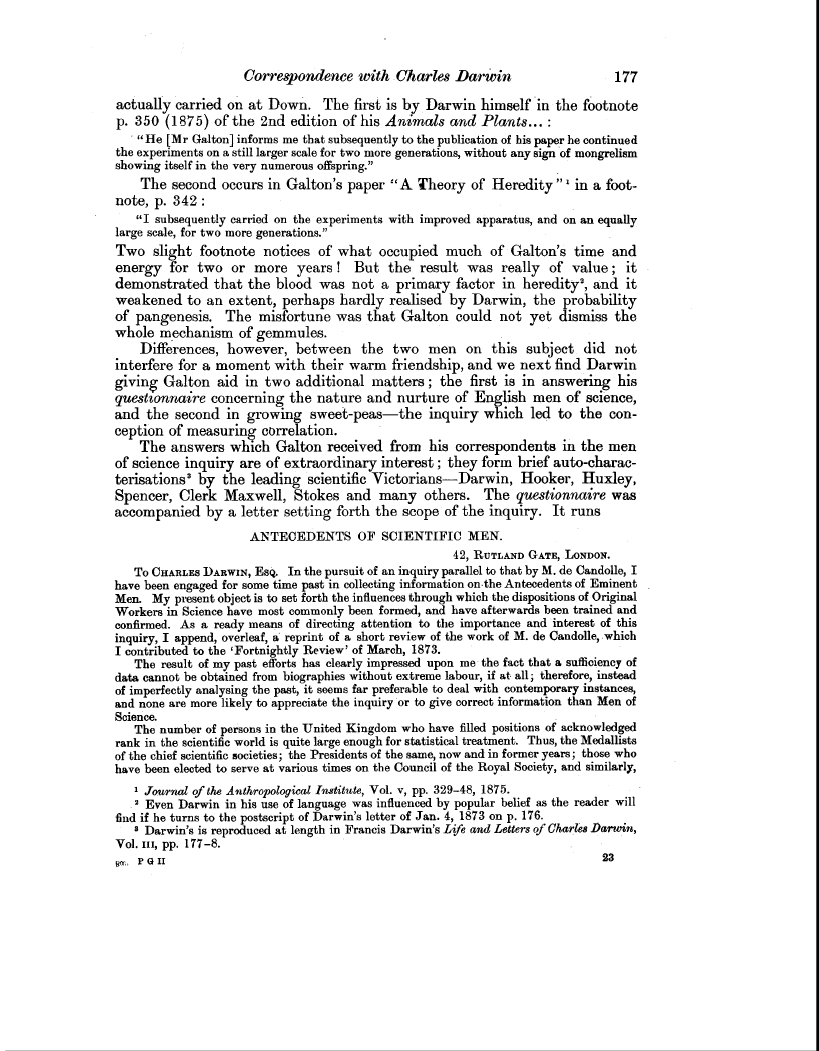Correspondence with Charles Darwin 177
actually carried on at Down. The first is by Darwin himself in the footnote p. 350 (1875) of the 2nd edition of his Animals and Plants...
"He [Mr Galton] informs me that subsequently to the publication of his paper he continued the experiments on a still larger scale for two more generations, without any sign of mongrelism showing itself in the very numerous offspring."
The second occurs in Galton's paper "A Theory of Heredity"' in a footnote, p. 342
"I subsequently carried on the experiments with improved apparatus, and on an equally large scale, for two more generations."
Two slight footnote notices of what occupied much of Galton's time and energy for two or more years ! But the result was really of value ; it demonstrated that the blood was not a primary factor in heredity, and it weakened to an extent, perhaps hardly realised by Darwin, the probability of pangenesis. The misfortune was that Galton could not yet dismiss the whole mechanism of gemmules.
Differences, however, between the two men on this subject did not interfere for a moment with their warm friendship, and we next find Darwin giving Galton aid in two additional matters ; the first is in answering his questionnaire concerning the nature and nurture of English men of science, and the second in growing sweet-peas-the inquiry which led to the conception of measuring correlation.
The answers which Galton received from his correspondents in the men of science inquiry are of extraordinary interest ; they form brief auto-characterisations' by the leading scientific Victorians-Darwin, Hooker, Huxley, Spencer, Clerk Maxwell, Stokes and many others. The questionnaire was accompanied by a letter setting forth the scope of the inquiry. It runs
ANTECEDENTS OF SCIENTIFIC MEN.
42, RUTLAND GATE, LONDON.
To CHARLES DARWIN, EsQ. In the pursuit of an inquiry parallel to that by M. de Candolle, I have been engaged for some time past in collecting information on-the Antecedents of Eminent Men. My present object is to set forth the influences through which the dispositions of Original
Workers in Science have most commonly been formed, and have afterwards been trained and confirmed. As a ready means of directing attention to the importance and interest of this inquiry, I append, overleaf, a reprint of a short review of the work of M. de Candolle,.which
I contributed to the 'Fortnightly Review' of March, 1873.
The result of my past efforts has clearly impressed upon me the fact that a sufficiency of data cannot be obtained from biographies without extreme labour, if at all; therefore, instead of imperfectly analysing the past, it seems far preferable to deal with contemporary instances, and none are more likely to appreciate the inquiry or to give correct information than Men of Science.
The number of persons in the United Kingdom who have filled positions of acknowledged rank in the scientific world is quite large enough for statistical treatment. Thus, the Medallists of the chief scientific societies; the Presidents of the same, now and in former years; those who have been elected to serve at various times on the Council of the Royal Society, and similarly,
1 Journal of the Anthropological Institute, Vol. v, pp. 329-48, 1875.
. 2 Even Darwin in his use of language was influenced by popular belief as the reader will find if he turns to the postscript of Darwin's letter of Jan. 4, 1873 on p. 176.
a Darwin's is reproduced at length in Francis Darwin's Life and Letters of Charles Darwin,
Vol. III, pp. 177-8.
gom. P O II 23

